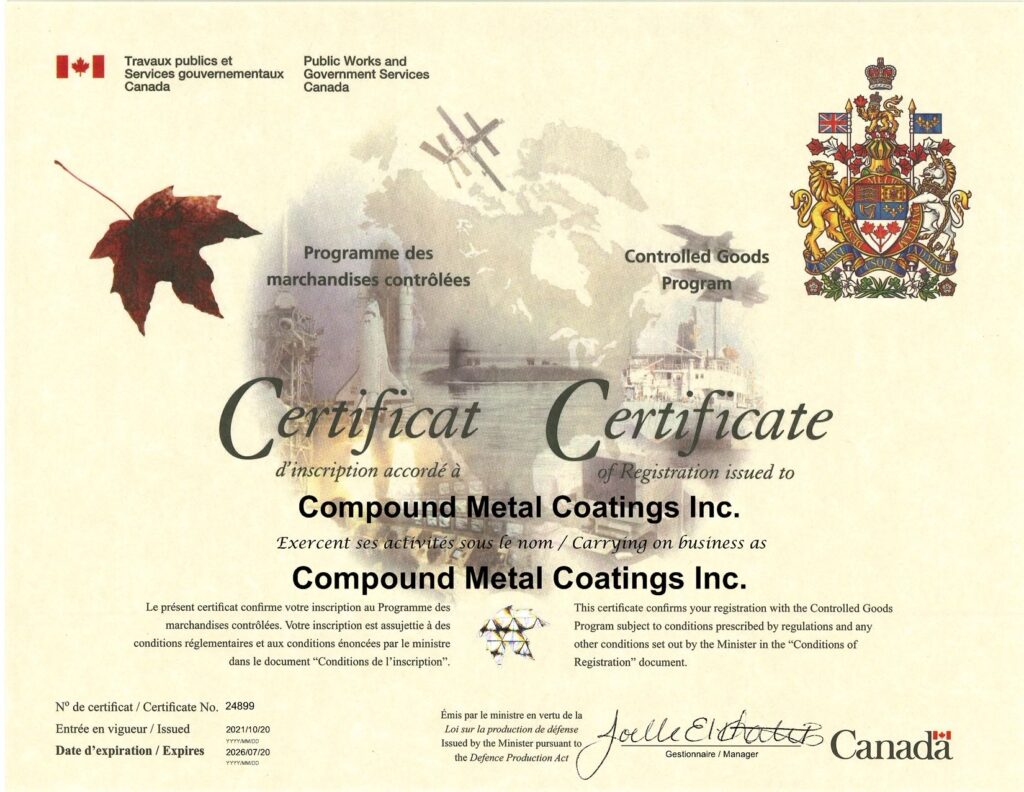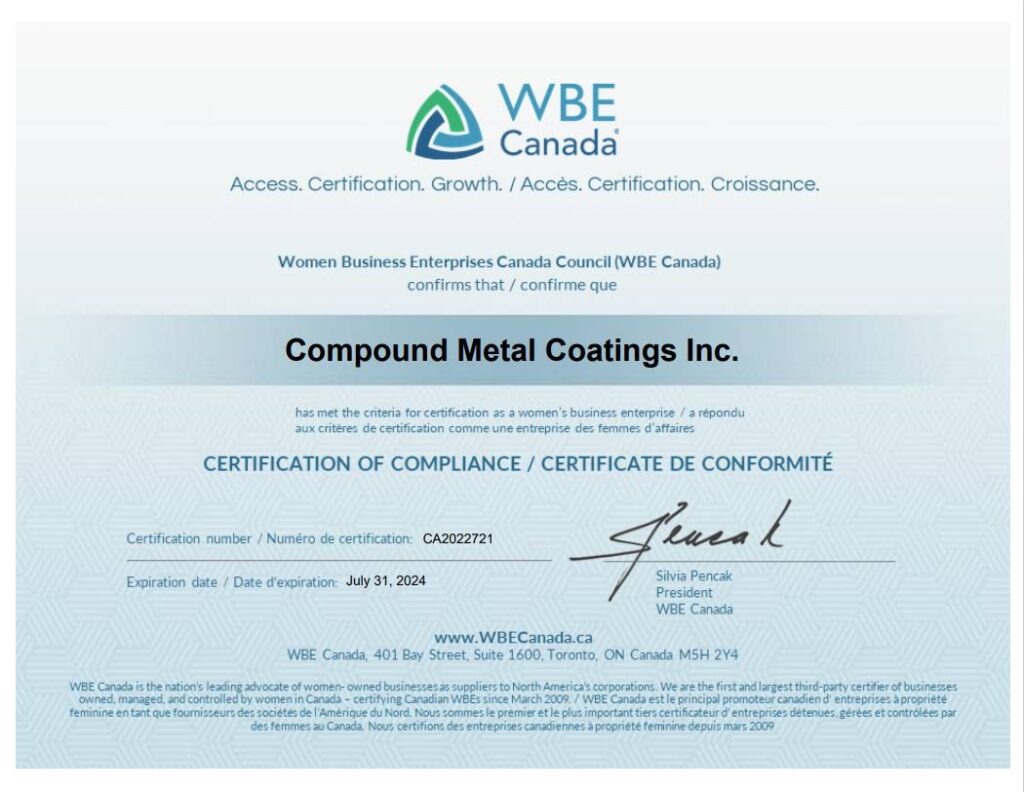Compound Metal Coating Inc.
Industry Vetted Professionals
Compound Metal Coatings Inc. is committed to providing high standard finishing services that satisfy customer expectations and requirements in a timely, cost effective and environmentally responsible manner.

ISO9001:2015
CMC is Controlled Goods Registered under CGP #17064 - valid until February 2017.
Canada Control Goods Certification
Controlled goods are primarily goods, including components and technical data that have military or national security significance, which are controlled domestically by the Government of Canada and defined in the Defence Production Act.


WBE Canada
CMC is a certified woman's business enterprise.
Our operations are in compliance with the following industry specifications
CONSENSUS STANDARDS
- ASTM B-733
- ASTM B-607
- Mil-C-26074E (AMS-26074): a military specification, approved for use by all Departments and Agencies of the Department of Defense
- AMS 2405
- AMS 2404
- AMS 2399
IN-HOUSE OR PROPRIETARY STANDARDS
- Ford: ESW-M1P65A
- Chrysler: PS-5009
- GM
- Aircraft companies: Boeing, Pratt Whitney
- Machinery equipment companies: Caterpillar, Applied Materials
SPECIFICATION REQUIREMENTS FOR MIL-C-26074E CLASSIFICATION Nickel coatings shall be classified in accordance with thermal treatment applied subsequent to plating:
-
Class 1: As plated, no subsequent heat treatment: a bake for hydrogen embrittlement relief is not considered a heat treatment.
-
Class 2: Heat treated to obtain required hardness. May be used on all metals not affected by heating to 500F and above. Coatings shall have a minimum hardness of 800 knoop or equivalent vickers when tested. Class 2 coatings on steel parts that have a hardness of 40 RCH or above are required to be tested without cracking of fracture. The desired hardness can be achieved by heating the part (see within 4 hours arter coating).
-
Class 3: Aluminum alloys non heat-treatable, and beryllium alloys processed to improve adhesion of the nickel deposit. Non heat-treatable aluminum parts shall be heated for 1 to 1.5 hours at 375F to improve adhesion of nickel deposit.
-
Class 4: Aluminum alloys, heat-treatable, processed to improve adhesion of the nickel deposit. Heat-treatable aluminum alloys shall be heated between 240F to 260F for 1 to 1.5 hours to improve adhesion of nickel deposit.
NOTE: These alloy types and grades may undergo microstructural changes when heated to 375F. Nickel coatings have the following grades:
- Grade A – O.0010-inch minimum thickness.
- Grade B – 0.0005-inch minimum thickness.
- Grade C – 0.0015-inch minimum thickness.
ASTM B-733 A standard specification for autocatalytic nickel-phosphorus coatings on metals:
- Type 1: No requirement for phosphorus
- Type 2: 1-3% P low phosphorus
- Type 3: 2-4% P low-med. phosphorus
- Type 4: 5-9% P medium phosphorus
- Type 5: 10 % + P high phosphorus
QUALITY Requirements for ASTM B-733:
- Appearance;
- Thickness – service condition;
- Adhesion – testing method ASTM B571;
- Porosity;
- Composition – alloy type;
- Microhardness – ASTM B578;
- Wear;
- Hydrogen embrittlement evaluation ASTM F519;
- and Corrosion resistance.
TESTING STANDARDS
- ASTM B117: A method of salt spray (fog) testing.
- ASTM B487: Measurement of metal and oxide coatings thickness by microscopical examination of a cross section
- ASTM B499: Standard test method for measurement of coating thickness by the magnetic method. Non magnetic coatings on magnetic base metals.
- ASTM B567: A method for measurement of coating thickness by the beta backscatter method.
- ASTM B568: X-Ray spectrometry
- ASTM B571: A test method for adhesion of metallic coatings.
- ASTM B578: A test method for microhardness of electroplated coatings.
- ASTM E18: Rockwell hardness and rockwell superficial hardness of metallic materials.
- ASTM E384: A test method for microhardness of materials.
- ASTM F519: Mechanical hydrogen embrittlement testing of plating processes and aircraft maintenance chemicals.


